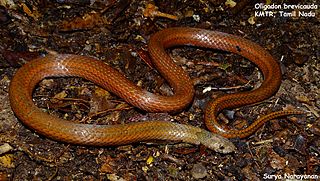
The prefrontal scales on snakes and other reptiles are the scales adjacent and anterior to the frontal, towards the tip of the snout, which are also in contact with the internasals.

The prefrontal scales on snakes and other reptiles are the scales adjacent and anterior to the frontal, towards the tip of the snout, which are also in contact with the internasals.

A snake skeleton consists primarily of the skull, vertebrae, and ribs, with only vestigial remnants of the limbs.

Children's python is a species of nonvenomous snake in the family Pythonidae. The species is named after John George Children. It is a nocturnal species occurring in the northern half of Australia and generally found on the ground, although it often climbs trees. Usually growing to about 1.0 m (3 ft) in length or more depending on the polymorphic variant, it is typically a reddish-brown colour, darker on the upper surface, and with many darker blotches, especially on younger specimens. The Stimson's python variant has much stronger and more variable colours; often being adorned with reddish-brown to chocolate blotches against lighter tan. It feeds mostly on small mammals and birds, and as with other pythons, it constricts its prey before swallowing it whole. It is a popular pet among reptile enthusiasts.

Ahaetulla prasina is an arboreal, moderately venomous species of opisthoglyphous snake in the family Colubridae to southern and Southeast Asia. Its common names include the Asian vine snake, Boie's whip snake, Gunther's whip snake, and the Oriental whip snake.

Gonyosoma prasinum is a species of colubrid snake found in Asia.
Gongylosoma nicobariensis, the Camorta Island stripe-necked snake, is a species of snake found in the Nicobar Islands of India. Species known only from its holotype.

Lycodon aulicus, commonly known as the Indian wolf snake or common wolf snake, is a species of nonvenomous snake found in South Asia and Southeast Asia. Early naturalists have suggested its resemblance to the venomous common krait as an instance of Batesian mimicry.

The banded kukri snake, russet kukri snake, or common kukri snake,, is a species of nonvenomous colubrid found mainly in South Asia.

Oligodon brevicauda, the shorthead kukri snake, is a species of snake found in the Western Ghats of India.

Ptyas mucosa, commonly known as the Oriental rat snake, dhaman or Indian rat snake, is a common non-venomous species of colubrid snake found in parts of South and Southeast Asia. Dhamans are large snakes. Typical mature total length is around 1.5 to 1.95 m though some exceed 2 m. The record length for this species was 3.7 m, second only to their cousin Ptyas carinata among living colubrid snakes. Despite their large size, oriental ratsnakes are usually quite slender with even a specimen of 2 m commonly measuring 4 to 6 cm only around in diameter. Furthermore, the average weight of ratsnakes caught in Java was around 877 to 940 g, though larger males of over 2.3 m may easily weigh over 2.5 kg (5.5 lb). Their color varies from pale browns in dry regions to nearly black in moist forest areas. Rat snakes are diurnal, semi-arboreal, non-venomous, and fast-moving. Rat snakes eat a variety of prey and are frequently found in urban areas where rodents thrive.

The checkered keelback, also known commonly as the Asiatic water snake, is a common species in the subfamily Natricinae of the family Colubridae. The species is endemic to Asia. It is non-venomous.

Hydrophis melanocephalus, commonly known as the slender-necked sea snake, is a species of venomous sea snake in the family Elapidae.

Snakes, like other reptiles, have skin covered in scales. Snakes are entirely covered with scales or scutes of various shapes and sizes, known as snakeskin as a whole. A scale protects the body of the snake, aids it in locomotion, allows moisture to be retained within, alters the surface characteristics such as roughness to aid in camouflage, and in some cases even aids in prey capture. The simple or complex colouration patterns are a property of the underlying skin, but the folded nature of scaled skin allows bright skin to be concealed between scales then revealed in order to startle predators.

Frontal scale refers to the scale of a reptile which lies on the top of the head in the region between the eyes. This is analogous to the frontal bone of a human which corresponds to the forehead.

Micrelaps is a genus of rear-fanged mildly venomous snakes. It is the only genus in the family Micrelapidae. The genus is native to Africa and the Middle East, and there are four species that are recognized as being valid.

Macrelaps is a monotypic genus created for the rear-fanged (opisthoglyphous) venomous snake species, M. microlepidotus, endemic to South Africa. No subspecies are currently recognised.
The Cameroon racer, Poecilopholis cameronensis, is a species of rear-fanged mildly venomous snake endemic to Africa. Poecilopholis is a monotypic genus created for this species.

Amblyodipsas unicolor, commonly known as the western glossy snake or the western purple-glossed snake, is a species of rear-fanged snake in the family Atractaspididae. It is one of the better known species in the genus Amblyodipsas.
In snakes, the canthals are the scales along the upper surface of the canthus rostralis. They are located behind the level of the prenasal/postnasal suture and before the supraocular. They are also described as being located along the edge of the crown between the internasals and the supraoculars. If these are large scales that contact each other along the midline, they are more properly referred to as prefrontals.

Synophis is a genus of snakes in the family Colubridae. The genus is endemic to northwestern South America.
Xenophidion is a genus of snakes first described in 1995, and the only genus of the monotypic family Xenophidiidae. Commonly referred to as spinejaw snakes, this genus is found in Borneo and peninsular Malaysia.